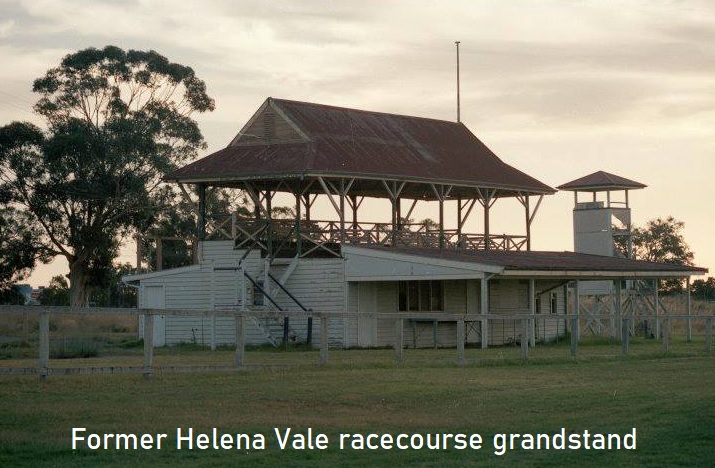Earliest Meeting:-Saturday 9th April 1898
Final Meeting:-March 1969
In 1897, an area of approximately 150 acres of mostly scrub land and bush, was purchased for the purpose of creating a racecourse in the eastern part of Perth, Western Australia. The track was to provide easy access for patrons and horses, being situated near Midland Junction and close to the Albany railway line, approximately 20kms from Perth city centre. Owned and operated by the Helena Vale Race Club, the course began construction in 1898. The track itself was approximately a mile and a quarter round and two chains wide, making it similar in size to the main Perth racecourse at Ascot. The width was later reduced by approximately half a chain. The length of the straight was two furlongs, which was amongst the longest in the Western Australian colony at the time. To encourage the betting public, totaliser machines were installed in the enclosure and on the flat. The stands and jockey's room were constructed of good quality jarrah, a local hardwood renowned for its appearance and durability. To accommodate the horses, thirty-two stalls were constructed along with a large parade ring and a chaff-house for any feed required. A number of latrines were built for the patron's comfort. In the early part of the 20th century, free stabling for horses racing at the course could be obtained at the East Midland Hotel (now the Darling Range Hotel). Board and residence for their human counterparts would cost extra.
The first race meeting was scheduled to be held on March 17th 1898. It was a six-race programme with £265 in stake money. This meeting was subsequently postponed due to the track not being completed in time, and the inaugural meeting took place on April 9th 1898. Season membership was fixed at £2 2s and, notwithstanding a very hot and dry day, a good crowd was there to witness the inaugural programme. The first race was a handicap with only three starters and Mr A. B. Lockyer's 8yr old brown mare Bijou had the honour of being the first winner at the new course. The Vale Handicap of five furlongs was the main race on the programme and it was marked with controversy as Black Boolka was first past the post but was subsequently disqualified and the race awarded to Thunder. Black Boolka managed to salvage something for his days efforts as he also competed in the fifth race, which he won and was allowed to keep. The final race was a walk-over awarded to Nancy Lee. By the turn of the century, hurdle races were also being included on the programme, along with weight-for-age events. By the time of the Great War, prize money had risen to 450 sovereigns (most races were worth £70 and one race worth £100) for the programme.

Local entrepreneur and well-known racing identity, Patrick (Lucky) Connolly took a controlling share of the race course after the First World War, which continued until the Western Australian Turf Club took over in 1945. Connolly was a strong influence in the Western Australian racing scene and the Helena Vale course was widely promoted during his ownership. Racing at the course ceased for a period during both the first and second world wars, where the Helena Vale Race Club leased their meeting dates to the Goodwood Race Club to accommodate these wartime requirements. A branch station of the Eastern Railway line serviced the race course patrons and was used to transport troops from the nearby Blackboy Hill training grounds during the First World War and the racecourse itself was also used for training and storage. During the Second World War, the Helena Vale course was again seconded as a storage facility for the Red Cross.
Over the years, the Helena Vale course hosted a number of Western Australia's best race horses. Perhaps the most illustrious horse to grace the Helena Vale turf was Blue Spec, a winner of the Perth, Mooney Valley and Melbourne Cups. Owned by the future major shareholder in the course, 'Lucky' Connolly, Blue Spec was the winner of the 1907 Helena Vale Cup, a handicap over a mile and a quarter worth 130 sovereigns. Mistico, a champion local galloper in the early part of the 20th century, won the Midland Stakes in 1915, beating another outstanding horse in Jolly Beggar, a previous winner of the Perth Cup. The best stayers in Western Australia, including Perth Cup winners Jolly Cosy (1922), and dual Perth Cup winner Cueeson (1933, 1934), along with notable short course sprinters such as the outstanding Aptofine, winner of the 1952 Railway Stakes, all raced on the Helena Vale turf.
By the 1950's, the quality of racing at Helena Vale had diminished and it was being considered more as a good provincial track when compared to the larger metropolitan courses at Ascot and Belmont. Although the welter events and handicaps were no longer attracting the better class of horse they had in previous years, the Helena Vale Cup was still considered a top class race, being contested by Perth Cup winners such as Beau Scot in 1955. Racing continued at Helena Vale until March 1969, when the course was officially closed. It remained a track for trials and training for the next thirteen years, until it was sold in 1982 to become an industrial estate in what is now known as Midvale. Nothing of the old course remains and the only reminder of the area's racing heritage lies in a number of the streets on the estate, which are named after winners of the Perth Cup.



